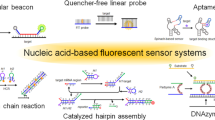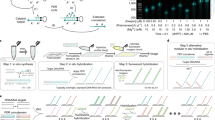Abstract
We report an approach for developing combinatorial fluorescence energy transfer (CFET) tags by tuning the tags' fluorescence emission signatures. The tags can all be excited at a single wavelength and analyzed by a simple optical system. We constructed eight CFET tags with unique fluorescence signatures, detected by a three-color capillary array electrophoresis (CAE) system with 488 nm excitation, using only three fluorescent dyes. A 1′,2′-dideoxyribose phosphate spacer was used to separate the donor and acceptor to tune the energy transfer efficiency, generating unique fluorescence signatures. The spacer also served as an electrophoretic mobility tag to tune the mobility of CFET-labeled DNA for multiplex detection of single-nucleotide polymorphisms (SNPs). Six nucleotide variations were identified simultaneously using six CFET tags on synthetic DNA templates and on a PCR product from the retinoblastoma tumor suppressor gene.
This is a preview of subscription content, access via your institution
Access options
Subscribe to this journal
Receive 12 print issues and online access
$209.00 per year
only $17.42 per issue
Buy this article
- Purchase on Springer Link
- Instant access to full article PDF
Prices may be subject to local taxes which are calculated during checkout




Similar content being viewed by others
References
Speicher, M.R., Ballard, S.G. & Ward, D.C. Karyotyping human chromosomes by combinatorial multi-fluor FISH. Nat. Genet. 12, 368–375 (1996).
Schröck, E. et al. Multicolor spectral karyotyping of human chromosomes. Science 273, 494–497 (1996).
Bruchez, M., Moronne, M., Gin, P., Weiss, S. & Alivisatos, A.P. Semiconductor nanocrystals as fluorescent biological labels. Science 281, 2013–2016 (1998).
Förster, T. In Modern quantum chemistry, Istanbul Lectures, Part III. (ed. Sinanoglu, O.) 93–137 (Academic Press, New York, 1965).
Stryer, L. Fluorescence energy transfer as a spectroscopic ruler. Annu. Rev. Biochem. 47, 819–846 (1978).
Cha, A., Snyder, G.E., Selvin, P.R. & Bezanilla, F. Atomic scale movement of the voltage-sensing region in a potassium channel measured via spectroscopy. Nature 402, 809–813 (1999).
Fairclough, R.H. & Cantor, C.R. The use of singlet-singlet energy transfer to study macromolecular assemblies. Methods Enzymol. 48, 347–379 (1978).
Ju, J., Ruan, C., Fuller, C.W., Glazer, A.N. & Mathies, R.A. Fluorescence energy transfer dye-labeled primers for DNA sequencing and analysis. Proc. Natl. Acad. Sci. USA 92, 4347–4351 (1995).
Rosenblum, B.B. et al. New dye-labeled terminators for improved DNA sequencing patterns. Nucleic Acids Res. 25, 4500–4504 (1997).
Miyawaki, A. et al. Fluorescent indicators for Ca2+ based on green fluorescent proteins and calmodulin. Nature 388, 882–887 (1997).
Chen, C.T., Wagner, H. & Still, W.C. Fluorescent, sequence-selective peptide detection by synthetic small molecules. Science 279, 851–853 (1998).
Tyagi, S. & Kramer, F.R. Molecular beacons: probes that fluoresce upon hybridization. Nat. Biotechnol. 14, 303–308 (1996).
Chen, X., Zehnbauer, B., Gnirke, A. & Kwok, P.-Y. Fluorescence energy transfer detection as a homogeneous DNA diagnostic method. Proc. Natl. Acad. Sci. USA 94, 10756–10761 (1997).
Kheterpal, I. & Mathies, R.A. Capillary array electrophoresis DNA sequencing. Anal. Chem. 71, 31A–37A (1999).
Ju, J., Glazer, A.N. & Mathies, R.A. Cassette labeling for facile construction of energy transfer fluorescent primers. Nucleic Acids Res. 24, 1144–1148 (1996).
Landegren, U., Kaiser, R., Sanders, J. & Hood, L. A ligase-mediated gene detection technique. Science 241, 1077–1080 (1988).
Barany, F. Genetic disease detection and DNA amplification using cloned thermostable ligase. Proc. Natl. Acad. Sci. USA 88, 189–193 (1991).
Schubert, E.L., Hansen, M.F. & Strong, L.C. The retinoblastoma gene and its significance. Ann. Med. 26, 177–184 (1994).
Acknowledgements
We thank J. Chen for supplying the RB1 gene sample. This research was supported by a grant from National Science Foundation (Biophotonics Partnership Initiative Grant 86933) and Columbia University Genomics Initiative. We also acknowledge Amersham Pharmacia Biotech for its support of the MegaBACE capillary array electrophoresis system.
Author information
Authors and Affiliations
Rights and permissions
About this article
Cite this article
Tong, A., Li, Z., Jones, G. et al. Combinatorial fluorescence energy transfer tags for multiplex biological assays. Nat Biotechnol 19, 756–759 (2001). https://doi.org/10.1038/90810
Received:
Accepted:
Published:
Issue Date:
DOI: https://doi.org/10.1038/90810
This article is cited by
-
A bead-based single nucleotide polymorphism (SNP) detection using melting temperature on a microchip
Microfluidics and Nanofluidics (2014)
-
Conditionally fluorescent molecular probes for detecting single base changes in double-stranded DNA
Nature Chemistry (2013)
-
Fluorescent hybridization probes for nucleic acid detection
Analytical and Bioanalytical Chemistry (2012)
-
Self-assembled nanoscale biosensors based on quantum dot FRET donors
Nature Materials (2003)
-
Single nucleotide polymorphism genotyping: biochemistry, protocol, cost and throughput
The Pharmacogenomics Journal (2003)



